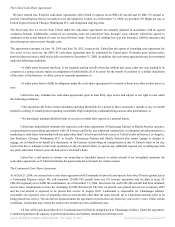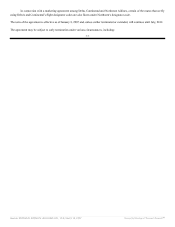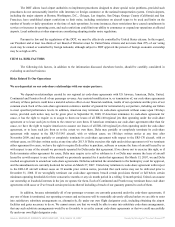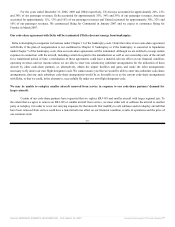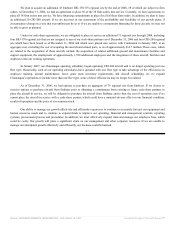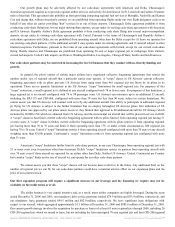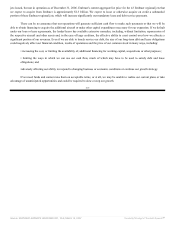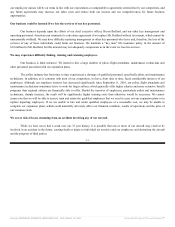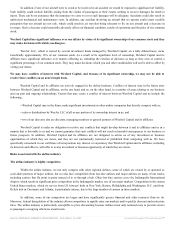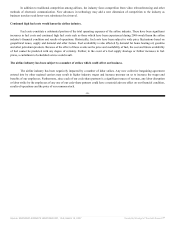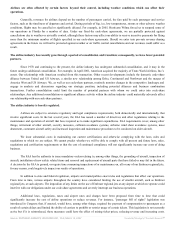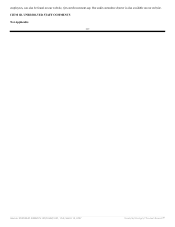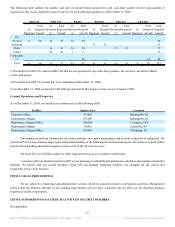Frontier Airlines 2006 Annual Report Download - page 35
Download and view the complete annual report
Please find page 35 of the 2006 Frontier Airlines annual report below. You can navigate through the pages in the report by either clicking on the pages listed below, or by using the keyword search tool below to find specific information within the annual report.
We currently depend on Embraer to supply us with the aircraft we require to expand.
Currently, we are obligated under our code-share agreements to place an additional 43 Embraer regional jets in service
through 2008, not including four 70-seat regional jets delivered, but unassigned as of December 31, 2006. We are dependent on
Embraer as the manufacturer of all of these jets. Our risks in relying primarily on a single manufacturer include:
• the possibility that Embraer could refuse, or may not be financially able, to perform its obligations under the purchase
agreement for the delivery of the regional jets;
• a fire, strike or other event could occur that affects Embraer's ability to completely or timely fulfill its contractual
obligations;
• the failure or inability of Embraer to provide sufficient parts or related support services on a timely basis;
• the interruption of fleet service as a result of unscheduled or unanticipated maintenance requirements for these aircraft;
• the issuance of FAA directives restricting or prohibiting the use of Embraer regional jets or requiring time-consuming
inspections and maintenance; and
• the adverse public perception of a manufacturer as a result of an accident or other adverse publicity.
Any disruption or change in the delivery schedule of these Embraer regional jets would affect our overall operations and our
ability to fulfill our obligations under our code-share agreements.
Further, ERJ-170 and ERJ-175 aircraft began operating in the commercial airline market in February 2004 and July 2005,
respectively. As relatively new products, these aircraft have been, and may continue to be, subject to unforeseen manufacturing and/or
reliability issues.
Our operations could be materially adversely affected by the failure or inability of Embraer or any key component
manufacturers to provide sufficient parts or related support services on a timely basis or by an interruption of fleet service as a result
of unscheduled or unanticipated maintenance requirements for our aircraft.
Reduced utilization levels of our aircraft under the fixed-fee agreements would adversely impact our revenues and earnings.
Our agreements with US Airways, American, Delta, United, Continental and Frontier require each of them to schedule our
aircraft to a minimum level of utilization. However, the aircraft have historically been utilized more than the minimum requirement.
Even though the fixed-fee rates may adjust, either up or down, based on scheduled utilization levels or require a fixed amount per day
to compensate us for our fixed costs, if our aircraft are at or below the minimum requirement (including taking into account the stage
length and frequency of our scheduled flights) we will likely lose both the opportunity to recover a margin on the variable costs of
flights that would have been flown if our aircraft were more fully utilized and the opportunity to earn incentive compensation on such
flights. For example, as a result of Delta's bankruptcy, Delta has utilized our smaller aircraft at less than historical levels.
Increases in our labor costs, which constitute a substantial portion of our total operating costs, will directly impact our
earnings.
Labor costs constitute a significant percentage of our total operating costs, and we have experienced pressure to increase
wages and benefits for our employees. Under our code-share agreements, our reimbursement rates contemplate labor costs that
increase on a set schedule generally tied to an increase in the consumer price index or the actual increase in the contract. We are
entirely responsible for our labor costs, and we may not be entitled to receive increased payments for our flights if our labor costs
increase above the assumed costs included in the reimbursement rates. As a result, a significant increase in our labor costs above the
levels assumed in our reimbursement rates could result in a material reduction in our earnings. We have collective bargaining
agreements with our pilots, customer service employees, flight attendants and dispatchers. Our pilots, dispatchers and flight attendant
agreements are amendable in October 2007, February 2007 and September 2009, respectively. Our Customer Service Agreement is
currently amendable and being negotiated and we expect it to be amended in 2007. We cannot assure you that future agreements with
Source: REPUBLIC AIRWAYS HOLDINGS INC, 10-K, March 15, 2007 Powered by Morningstar® Document Research℠


